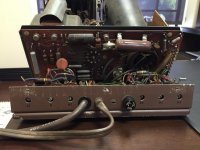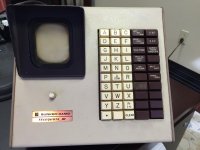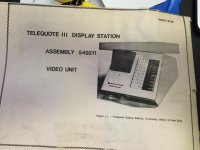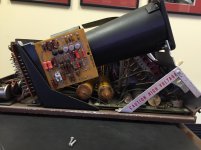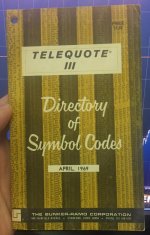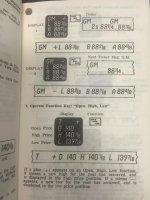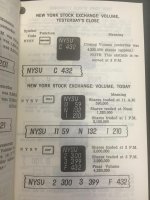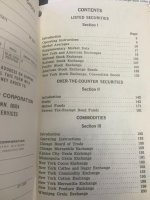Upcoming Events:
- VCF South West - June 14 - 16, Davidson-Gundy Alumni Center at University of Texas at Dallas
- VCF West - Aug 2 - 3, Computer History Museum, Mountain View, CA
- VCF Midwest - Sept 7 - 8 2024, Schaumburg, IL
- VCF SoCal - Mid February 2025, Location TBD, Southern CA
- VCF East - April 2025, Infoage Museum, Wall NJ
-
Please review our updated Terms and Rules here
You are using an out of date browser. It may not display this or other websites correctly.
You should upgrade or use an alternative browser.
You should upgrade or use an alternative browser.
Bunker-Ramo Telequote III
- Thread starter simkiss
- Start date
Chuck(G)
25k Member
I'm old enough to have held stock in Bunker-Ramo (eaten by Allied Chemical). A very early 1960 sinteractive terminal used by stockbrokers in place of the old tickertape and telephone. There, to the best of my recollection, are no "smarts" in this thing; it connects to a BR controller, which, in turn was linked via leased line to BR's site running Honeywell iron.
So, I'm not exactly sure what you'd like to do.
So, I'm not exactly sure what you'd like to do.
You are correct that its a dumb terminal that used to connect back to the Trumbull, CT data center via leased Western Union lines. I do have the schematics/manual, but they are under some heavy books for a few weeks to de-curl them. I guess, first I need to recap the thing. The 3" green phosphorus CRT doesn't work - hopefully recapping it will fix that. Then I want to figure out the messaging format and attempt to hook up the AM/P connector to a Raspberry Pi and then the Pi to Bloomberg in order to pull in live quotes. I will need help identifying parts suitable for replacement, tips on getting the ancient CRT back on if recapping doesn't work, and thoughts on how to decrypt the ancient messaging format and pinouts to bring her back to life with live quotes.
simkiss said:...I do have the schematics/manual...first I need to recap the thing...Then I want to figure out the messaging format...and thoughts on how to decrypt the ancient messaging format...
As we talked last night in IRC about this... count me in on some of the engineering analysis support... schematics and manuals will be interesting when they're available. I'm an electrical engineer but only my uncles designed with tubes; I'll be looking for the circuitry *smarts* for encoding and communications.
This is about the same electronics era as my Randomatic sorter. I suspect the logic board to be diodes, resistors and transistors. Might even be an Intel 4004 as this is a luxury item. The circuit board assemblies should be really interesting.
You'll need active restoration experts here and on IRC to help with the re-caps and the power supply restoration. I'll be thinking about the stock simulator too and how to code that efficiently.
"...early 1960 sinteractive terminal used by stockbrokers..."
Typo... but I couldn't have stated it better.
Last edited:
Chuck(G)
25k Member
Well, if you can get the CRT heater to light up, odds are that it's good. "Dumb" doesn't describe the device correctly--it's much less than a traditional "dumb" RS232C terminal or TTY. It's basically a simple monitor and a bunch of pushbuttons. At any rate, it looks like it's in remarkably good shape.
My guess is that there will be a considerable amount of interface circuitry involved.
My guess is that there will be a considerable amount of interface circuitry involved.
Chuck(G)
25k Member
Even if the 4004 had come out, I doubt that it would have been used in this thing. The whole point of B-R's Telequote system was reliability. There was a considerable amount of redundancy in the system. I doubt that there's even an integrated circuit in this thing--maybe a transistor array, but that's about it. Ultra-conservative design.
The schematic would be helpful.
The schematic would be helpful.
vwestlife
Veteran Member
Anyone who knows how to work on a vintage TV or oscilloscope could restore it and get it "working"... but I put "working" in quotes because you'd need to recreate the infrastructure it was originally connected to, in order to get it to actually do anything! Otherwise, it'd just be a cool-looking prop.
g4ugm
Veteran Member
Pretty that you could use an FPGA to provide the controller status.
Chuck(G)
25k Member
Looking at the thing, this is probably no more or less than an electrostatic-deflection CRT with a few bits of interface to the pushbutton. I don't even think that the CRT is raster-scanned--it's probably just buffers the deflection circuitry and brings the result out to X and Y input lines.
As I recall these things, the display was very crude--perhaps 4 lines of no more than about 10 characters each, if that. Very blocky-looking stuff.
As I recall these things, the display was very crude--perhaps 4 lines of no more than about 10 characters each, if that. Very blocky-looking stuff.
kyodai
Experienced Member
Wow, just saw that the auction ended for over 600 Dollar! Definitely neat collectible, but for being merely more than a decoration piece for stock brokers also quite expensive... :bigeyes:
Found this text in the August 1968 issue of Electronics World:
Bunker- Ramo's Telequote® III units were first installed in
1964; over 13,000 are now in use. Using a 3 -inch cathode -
ray tube, this device can display up to 700 characters per
second. Each displayed character is composed from a 7 X 5
dot pattern. If a price is superseded during viewing, the
new price is posted as you watch. In addition to displaying
specific information that has been requested, Telequote ill
can display "Mini-Trends ", a continuously changing display
of key market indices. (Telequote Ill is also available with a
printed tape output.)
Bunker- Ramo's Telequote® III units were first installed in
1964; over 13,000 are now in use. Using a 3 -inch cathode -
ray tube, this device can display up to 700 characters per
second. Each displayed character is composed from a 7 X 5
dot pattern. If a price is superseded during viewing, the
new price is posted as you watch. In addition to displaying
specific information that has been requested, Telequote ill
can display "Mini-Trends ", a continuously changing display
of key market indices. (Telequote Ill is also available with a
printed tape output.)
Chuck(G)
25k Member
Yup, that display is what I remember. Very sparse, with roughly-formed characters.
B-R Telequote, however, was not the first into the business of delivering stock market data electronically via a terminal. That distinction goes to Quotron (started in 1960). An early Quotron terminal would probably fetch a pretty penny today.
B-R Telequote is most notable for being involved in squabbles with the FCC, SEC and various taxing entities. A lot of caselaw was determined back then.
B-R Telequote, however, was not the first into the business of delivering stock market data electronically via a terminal. That distinction goes to Quotron (started in 1960). An early Quotron terminal would probably fetch a pretty penny today.
B-R Telequote is most notable for being involved in squabbles with the FCC, SEC and various taxing entities. A lot of caselaw was determined back then.
Yup, that display is what I remember. Very sparse, with roughly-formed characters.
B-R Telequote, however, was not the first into the business of delivering stock market data electronically via a terminal. That distinction goes to Quotron (started in 1960). An early Quotron terminal would probably fetch a pretty penny today.
B-R Telequote is most notable for being involved in squabbles with the FCC, SEC and various taxing entities. A lot of caselaw was determined back then.
There was another dispute between Western Union and B-R over the Telequote IV which was going to allow messaging between terminals. That turned into the NASDAQ, but not before WU refused to lease lines to B-R claiming that such a switching service was in direct violation of their service agreement and was not permitted.
B-R complained to the FCC, which decided in favor of B-R, and that decision was used (in part) to justify the FCC's recent net neutrality policies.
Also, you are correct about Scantlin being first in 1962 to get quotes from the NYSE to brokers via a centralized CDC 160A. However those machines used paper tape, and maybe some nixie tubes. B-R was the first with a CRT.
Last edited:
ctgolfer36
New Member
- Joined
- Mar 25, 2017
- Messages
- 2
You are correct that its a dumb terminal that used to connect back to the Trumbull, CT data center via leased Western Union lines. I do have the schematics/manual, but they are under some heavy books for a few weeks to de-curl them. I guess, first I need to recap the thing. The 3" green phosphorus CRT doesn't work - hopefully recapping it will fix that. Then I want to figure out the messaging format and attempt to hook up the AM/P connector to a Raspberry Pi and then the Pi to Bloomberg in order to pull in live quotes. I will need help identifying parts suitable for replacement, tips on getting the ancient CRT back on if recapping doesn't work, and thoughts on how to decrypt the ancient messaging format and pinouts to bring her back to life with live quotes.
The whole system was propriatary and will be all but impossible to hookup to Bloomberg or any other system. The terminal you have is nothing but a CRT without any control logic, and a keyboard. It attaches to a office controller called an RQT, which supported 3 to 29 terminals depending on the model. In turn, the RQT attached to a multi-drop 1200BPS line that was shared with as many as 10 RQT. This 1200BPS line was attached to a hardwired computer system which had as many as 28 lines. This computer, of which there were 13 scattered around the USA were updated by a central site system which was at first located in NYC and later in Trumbull CT
But back to the terminal. The CRT had a unique saw tooth raster In the standard mode there were 4 lines of 6 characters. In the Trends mode there were 11 lines of 24 characters. The saw tooth raster had 6 lines and supported a 5 x 7 matrix plus a single space. Characters were formed from the lower left to the upper right plus a single line which spaced characters.
The keyboard was scanned by the RQT roughly every 20ms. If a key was depressed it placed a 6 bit code on the keyboard bus. Although I designed 2 of the 4 versions of the RQT I don't recall the timing or the format of the signal that controlled the CRT. Nor do I recall the CRT drive circuitry.
Good luck if you really try to get this working. The terminal is but a small part of the overall system.
ctgolfer36
New Member
- Joined
- Mar 25, 2017
- Messages
- 2
The office controller which supported the terminal was solid state, not vacuum tube. Three models of the office controller, known as RQT, were discrete transistor, the last version was TTL. I designed 2 of the 4 models.

